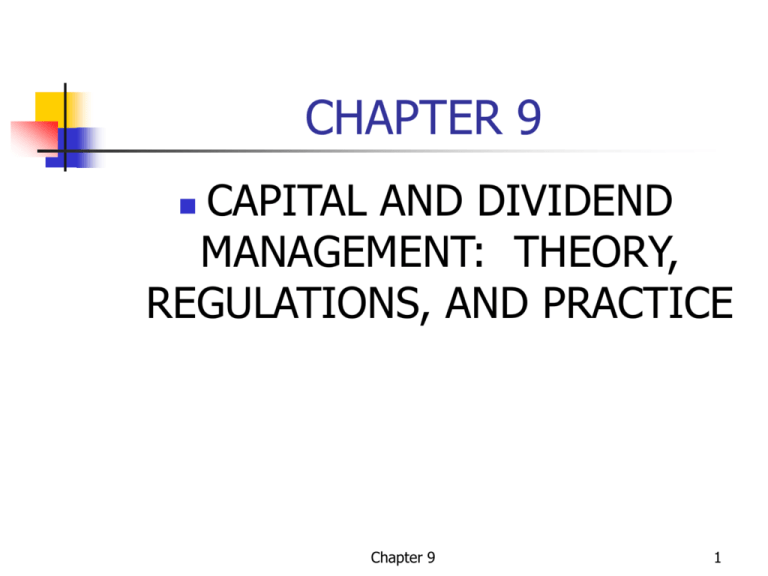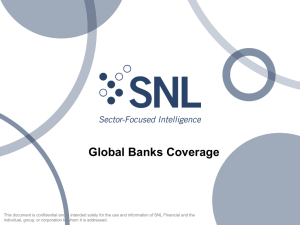Chapter 9
advertisement

CHAPTER 9 CAPITAL AND DIVIDEND MANAGEMENT: THEORY, REGULATIONS, AND PRACTICE Chapter 9 1 LEARNING OBJECTIVES TO UNDERSTAND… The theory of capital structure for an insured bank Regulatory capital-adequacy standards as implicit pricing of risk and to distinguish among GAAP, RAP, and market measures of bank capital Practical aspects of bank capital and dividend management as captured by, among other things, a bank’s confidence function, internal and external sources of capital, strategies for capital formation (including share repurchases), and the use of securities innovations such as trust-preferred stock Chapter 9 2 Cost of Bank Capital Recent Developments: Basel Accord on risk-based-capital (RBC) requirements (1992) – Mandates that banks and BHC’s determine their regulatory capital based on their exposure to credit risk Federal Deposit Insurance Corporation Improvement Act (FDICIA) (1991) – Attempts to reduce the moral-hazard and agency problems inherent in mispriced deposit insurance Chapter 9 3 Modigliani and Miller (M&M) (Figures 9-1 , p. 263) In a perfect capital market without bankruptcy costs and taxes, M&M have shown that the value of the firm is independent of its financial structure. But, to understand how financial structure affects the value of the firm, the concepts of tax shield and bankruptcy costs are critical. Chapter 9 4 Tax Shield of Debt Tax deductibility of interest expense increases the total income that a levered firm can pay out to both its stockholders and its bondholders. The value of the firm is equal to its value as a purely equity-financed firm plus the present value of the tax shield. Chapter 9 5 Bankruptcy Costs What stops firms from becoming purely debt-financed entities? Bankruptcy Costs/Costs of Financial Distress As a firm increases its use of debt, its risk of not being able to cover its interest expenses increases. Greater leverage eventually leads to a higher cost of capital. Chapter 9 6 Federal Safety Net The government guarantee (“G”) is the federal safety net for banks. Consists of deposit insurance, the Fed’s discount window, and the too-big-to-fail (TBTF) doctrine. Deposit Insurance and the Value of the Banking Firm (Fig. 8-3, p. 265, Buser, Chen and Kane [1981]) Conclusion: Banks accept regulatory interference because DI enhances the value of the banking firm Chapter 9 7 The Costs of Bank Financial Distress (1) (2) Market Discipline – Increased cost of funds (capital) Regulatory Discipline - Increased regulatory interference Chapter 9 8 Regulatory Interference and Capital Regulation Agency conflicts arise because of asymmetric information, dishonesty (moral hazard), and different goals and objectives The K in TRICK, which is the umbrella idea for regulatory interference attempts to resolve these agency conflicts Chapter 9 9 Cost of Equity Capital The return that shareholders expect to earn on their investment represents the implicit cost of equity capital. The expected total return [E(r)] can be viewed in terms of a dividend yield (D/P) and a price-appreciation or capital-gains yield (ΔP/P): [E(r)] = D/P + ΔP/P Chapter 9 10 A Bank’s Confidence Function Without G, confidence is function of capital adequacy (the K in TRICK), stability of earnings, and quality of information (the T in TRICK) With G, banks have substituted G for the other factors but especially capital See Figure 9-2 for a long view of bank capital Chapter 9 11 Risk Management and Regulatory Capital Standards Basel Accord – Mandates risk-based capital requirements for all banks regardless of their size thus marking a formal linkage between bank capital and risk management. By 12/31/92, all U.S. commercial banks and BHCs had to meet minimum risk-based capital requirements established jointly by the Federal Reserve, the Office of the Comptroller (OCC), and the Federal Deposit Insurance Corporation (FDIC). Chapter 9 12 Basel Reform (forthcoming 2002? 2003?) Existing (1992) weights for credit risk are too crude Bond-type ratings as shown in Table 9-2 represent an improvement In addition, comprehensive RBC requirements must take account of all the risks a bank faces See Table 9-2 (p. 272) and Box 9-2 (p. 276) Chapter 9 13 The Regulatory Dialectic in Practice Working Group on Public Disclosure (Box 9-1, p. 273-275) Cynic’s view is that the regulators are in the industry’s hip pocket and that they only give the industry what it wants More benign view is that of a working relationship as captured by the letter in Box 9-1 Chapter 9 14 Three Different Accounting Standards The Many Veils of Bank Bookkeeping 1. Book-Value Accounting (GAAP) 2. Regulatory Accounting (RAP) 3. Market-Value Accounting Chapter 9 15 GAAP To measure bank capital or accounting net worth, subtract the book value of liabilities from the book value of assets: NW = A – L, as long as NW > 0 If NW < 0, the bank is book-value insolvent Chapter 9 16 RAP Bankers prefer not to raise more costly equity to appease regulators, so they have regulators accept other instruments as regulatory capital. The idea is to incorporate securities into a bank’s capital structure that will be priced based on the bank’s risk exposure and thereby affect the bank’s cost of funds. Chapter 9 17 Market Value The total equity value of the firm is equal to: MVE = P x N P = Price Per Share N = Number of Shares Outstanding Critics claim market value accounting is much too volatile a measure versus book values Chapter 9 18 How Much Capital Is Adequate? “In both banking and industry, the adequacy of capital is an elusive measure. Perhaps the only real determinant is the aggregate consensus of the marketplace – that is, leverage, or the inverse of the capital ratio, should be extended until the marketplace reacts adversely and reflects concern.” James Ehlen Goldman Sachs Chapter 9 19 What’s the “Magic” Number? (Wayne Angell, former Fed Governor, 1991) “While picking an exact number is difficult, I am thinking of minimum bank capital on the order of ten percent tier one capital to risk-weighted assets. If ten percent seems surprisingly high, recall that prior to the institution of deposit insurance, bank capital ratios were normally above twenty percent. Moreover, median capital ratios in financial-services industries that do not have deposit insurance are today significantly higher than ten percent. Clearly, any move to increase bank capital requirements would need a long transition period, to minimize the problems banks might face raising capital.” See Figure 9-2, p. 264 Chapter 9 20 Key Components of Bank Capital (1) Common Stock (2) Surplus (3) Retained Earnings or undivided profits Table 9-3, p. 284, shows Citigoup/Citibank capital structure Chapter 9 21 Internal Capital Generation Rate (g) An important concept for the financial management of bank equity capital is the internal capital generation rate (g): g ≈ ROE x RR RR = Retention Rate – 1 minus the payout ratio (RR = 1 – PR) Chapter 9 22 External Sources of Capital When regulatory or market forces or both require a bank/BHC to increase its capital beyond its internal capital generation rate, the bank must turn to external sources of capital. Although both equity and debt capital are available for such purposes, under new the new guidelines of 1992, common equity has been assigned a more critical role. Chapter 9 23 Inadequate Capital and Ability to Obtain Equity Financing The inability to access capital markets can be taken as an indicator of distressed bank’s lack of viability or going-concern value. Chapter 9 24 Other CapitalFormation Strategies In addition to raising capital in debt and equity markets, banks have three additional “internal” methods for generating capital: (1) (2) (3) Dividend Reinvestment Plans Employee Stock Ownership Plans (ESOPs) Stock Dividends Chapter 9 25 Dividend-Reinvestment Plans Since these plans substitute stock dividends for cash dividends, they permit banks to conserve retained earnings that otherwise would be paid out in the form of cash dividends. Banks typically offer a five-percent discount from fair market value to encourage participation in dividend-reinvestment plans. Chapter 9 26 Employee Stock Ownership Plans (ESOPs) Since ESOPs fall under unique tax legislation, they are the only tax-deductible employee benefit plan that can be used as a direct source of capital for a bank. As a result, ESOPs can be financed largely with pretax dollars. Chapter 9 27 Stock Dividends Used in conjunction with ESOPs and thus offers a dual way for banks to raise capital. A stock dividend is simply a payment to shareholders in the form of stock rather than cash. Chapter 9 28 Banking and Investment Banking The relationship with an investment bank eases the burden of raising capital and worrying about the appeal of the bank’s stock. Many community banks do not have relationships with investment banks but should follow two basic guidelines in searching for one: (1) (2) Consider the range and content of investment-banking services that are needed. Follow a formal selection procedure in selecting an investment-banking firm so as to establish a “presence” as a client. Chapter 9 29 Stock-Repurchase Plans A company uses cash to buy back some of its outstanding shares. Share repurchases are in increasingly popular way for firms to pay cash to their shareholders, as opposed to paying cash dividends. Chapter 9 30 CHAPTER SUMMARY Does bank capital structure matter? Yes! Regulatory discipline captured by the K in TRICK for Kapital Adequacy has always been important, that’s why FDIC stands for Forever Demanding Increased Capital and the Basel Accord focuses on risk-based capital Market discipline also counts and affects a bank’s cost of funds Chapter 9 31 Chapter Summary (concluded) Defining bank capital is a thorny issue: “It must be perpetual but it doesn’t have to be forever. It has to feel like equity but look – to tax authorities – like debt. Defining banks’ core capital is one of the thorniest issues facing bank regulators” Anthony Currie, Euromoney Chapter 9 32






